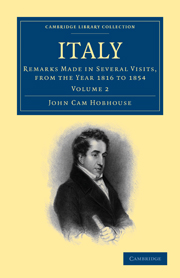Summary
THE CASTLE OF ST. ANGELO – TOMB OF HADRIAN
The Mole was constructed, it is thought, on the plan, nearly, of the Mausoleum of Augustus or of Cecilia Metella.
We must recur to Gibbon to notice two or three mistakes which he has made in his mention of this monument. The first occurs in his account of the defence of Rome by Belisarius, where he says that the sepulchre of Hadrian was then converted, “for the first time, to the uses of a citadel.” This does not seem probable, for the account given of it by Procopius tells us that it had become a sort of tower, and had, by additional works, been anciently joined to the walls of Rome. Donatus and Nardini believe it to have been fortified by Honorius at the first approach of the Goths, when he is recorded as having repaired the walls.
It preserved until the tenth century the name of the Prison or House of Theodoric, by which appellation it is designated once or twice so late as the fifteenth century; and this circumstance makes it appear that the Gothic monarch had made it capable of defence previously to the siege of the city by Vitiges.
The second error occurs in a note in the same place of the history, in which the breadth of the sides of the ancient square base is mistaken for the height above the walls.
- Type
- Chapter
- Information
- ItalyRemarks Made in Several Visits, from the Year 1816 to 1854, pp. 159 - 172Publisher: Cambridge University PressPrint publication year: 2009First published in: 1859



